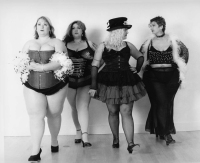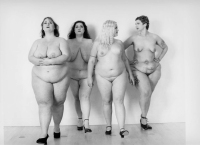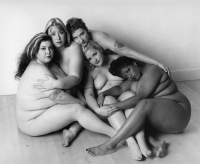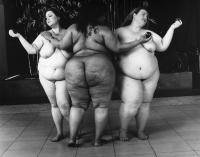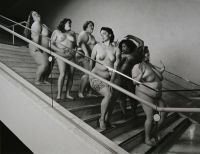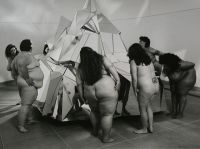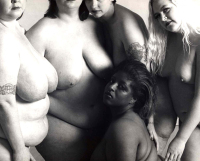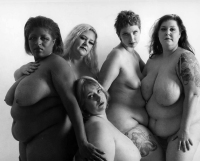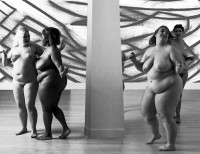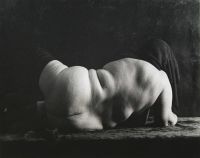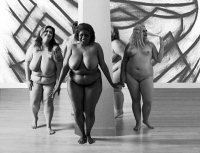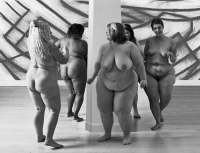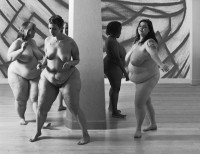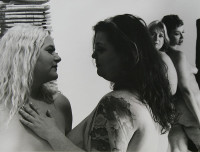Leonard Nimoy: The Full Body Project
The Full Body Project
Hardcover Book
Signed books are available.
Artist Statement
Who are these women? Why are they in these pictures? What are their lives about? How do they feel about themselves? These are some of the questions I wanted to raise through the images in this collection.
This current body of work is a departure for me. For a number of years, I have been producing images using the female figure. I have worked with numerous models who were professional people earning their living by posing, acting, dancing, or any combination thereof. But, as has been pointed out to me in discussions at exhibitions of my work, the people in these pictures always fell under the umbrella of a certain body type. I’ll call it a “classic” look. Always within range of the current social consensus of what is “beautiful.” In fact, that was the adjective I most often heard when my work was exhibited. The women as they appeared in my images were allotted no individual identity. They were hired and directed to help me express an idea—sometimes about sexuality, sometimes about spirituality—and usually about feminine power. But the pictures were not about them. They were illustrating a theme, a story I hoped to convey.
11×14 in
16×20 in
38.5×40 in
11×14 in
16×20 in
32×40 in
8×10 in
11×14 in
16×20 in
20×24 in
35×44 in
8×10 in
11×14 in
16×20 in
35×44 in
23×30 in
16×20 in
11×14 in
20×14 in
24×18 in
These women are interested in “fat liberation.” They hold jobs in the theater, the film industry and in business—and together they perform in a burlesque presentation called “Fat Bottom Revue.” The nature and degree of costuming and nudity in their performances is determined by the venue and the audience, which can range from children’s birthday parties, to stag parties. I wanted these pictures to be more about them. These women are projecting an image that is their own. And one that also stems fro m their own story rather than mine. Their self-esteem is strong. One of them has a degree in anthropology and will tell you that ideas of beauty and sexuality are “culture bound”—that these ideas are not universal or fixed, and that they vary and fluctuate depending on place and time. They will tell you that too many people suffer because the body they live in is not the body you find in the fashion magazines.
View photographs of Mr. Nimoy from the lecture and opening reception of The Full Body Project.
16×20 in
16×20 in
16×20 in
16×20 in
My process was simple, yet different than how I had worked in the past. I was initially interested in revisiting two works of female subjects by Herb Ritts and Helmut Newton: specifically Ritts’ image of a group of supermodels, who were posed nude and clustered together on the floor, and a Newton diptych wherein the two images are identical in pose, except one image showed the models clothed, and the other showed them unclothed. The models were shown the images by Herb Ritts and Helmut Newton and they were quite prepared to present themselves in response to the poses that those images suggested. I asked them to be proud, which was a condition they took to easily, quite naturally. Having completed the compositions that were initially planned, I then asked them to play some music that they had brought with them, and they quickly responded to the rhythms, dancing in a free-form circular movement with in the space. It was clear that they were comfortable with the situation, with each other, and were enjoying themselves.
On February 14, 2007, Leonard Nimoy interviewed with Stephen Colbert on the Colbert Report. The two discuss Nimoy’s Full Body Project and its challenge against American standards of beauty. Click here to watch the interview.
8×10 in
16×20 in
16×20 in
16×20 in
18×24 in
16×20 in
16×20 in
16×20 in
With these new images, I am now hearing different words. Sometimes “beautiful,” but with a different sub-text. I hear comments, which lead to questions. The questions lead to discussions—about beauty, social acceptability, plastic surgery, our culture and health. In these pictures these women are proudly wearing their own skin. They respect themselves and I hope that my images convey that to others.
Mr. Nimoy’s original photography ranges in price from $1,500 to $25,000 dependent on image, size of image (which range from 5″ x 7″ inches to life-size 67″ x 80″), and size of edition (all are small editions of between 2 and 25). B&W images were shot with film and hand printed by Mr. Nimoy in his darkroom. Color images are digital and the printing was personally supervised by Mr. Nimoy. All photographs are signed and numbered.

Heather MacAllister
We are sorry to report that Heather MacAllister Founder and Artistic Director of The Original Fat-Bottom Revue died Feb. 13, 2007 of ovarian cancer.
“Any time there is a fat person onstage as anything besides the butt of a joke, it’s political. Add physical movement, then dance, then sexuality and you have a revolutionary act.” —Heather MacAllister



